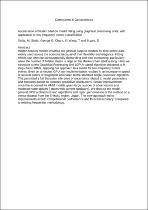 ResearchSpace
ResearchSpace
Acceleration of hidden Markov model fitting using graphical processing units, with application to low-frequency tremor classification
JavaScript is disabled for your browser. Some features of this site may not work without it.
- ResearchSpace
- →
- Research Publications/Outputs
- →
- Conference Publications
- →
- View Item
| dc.contributor.author |
Stoltz, M

|
|
| dc.contributor.author |
Stoltz, George G

|
|
| dc.contributor.author |
Obara, K

|
|
| dc.contributor.author |
Wang, T

|
|
| dc.contributor.author |
Bryant, D

|
|
| dc.date.accessioned | 2021-09-27T07:48:46Z | |
| dc.date.available | 2021-09-27T07:48:46Z | |
| dc.date.issued | 2021-11 | |
| dc.identifier.citation | Stoltz, M., Stoltz, G.G., Obara, K., Wang, T. & Bryant, D. 2021. Acceleration of hidden Markov model fitting using graphical processing units, with application to low-frequency tremor classification. <i>Computers & Geosciences, 156.</i> http://hdl.handle.net/10204/12113 | en_ZA |
| dc.identifier.issn | 0098-3004 | |
| dc.identifier.issn | 1873-7803 | |
| dc.identifier.uri | https://doi.org/10.1016/j.cageo.2021.104902 | |
| dc.identifier.uri | http://hdl.handle.net/10204/12113 | |
| dc.description.abstract | Hidden Markov models (HMMs) are general purpose models for time-series data widely used across the sciences because of their flexibility and elegance. Fitting HMMs can often be computationally demanding and time consuming, particularly when the number of hidden states is large or the Markov chain itself is long. Here we introduce a new Graphical Processing Unit (GPU)-based algorithm designed to fit long-chain HMMs, applying our approach to a model for low-frequency tremor events. Even on a modest GPU, our implementation resulted in an increase in speed of several orders of magnitude compared to the standard single processor algorithm. This permitted a full Bayesian inference of uncertainty related to model parameters and forecasts based on posterior predictive distributions. Similar improvements would be expected for HMM models given large number of observations and moderate state spaces ( states with current hardware). We discuss the model, general GPU architecture and algorithms and report performance of the method on a tremor dataset from the Shikoku region, Japan. The new approach led to improvements in both computational performance and forecast accuracy, compared to existing frequentist methodology. | en_US |
| dc.format | Abstract | en_US |
| dc.language.iso | en | en_US |
| dc.relation.uri | https://www.sciencedirect.com/science/article/pii/S0098300421001941 | en_US |
| dc.source | Computers & Geosciences, 156 | en_US |
| dc.subject | Bayesian methods | en_US |
| dc.subject | Computationally intensive methods | en_US |
| dc.subject | Low-frequency tremors | en_US |
| dc.subject | Shikoku region | en_US |
| dc.subject | Tremor forecast | en_US |
| dc.subject | Hidden Markov models | en_US |
| dc.subject | HMMs | en_US |
| dc.title | Acceleration of hidden Markov model fitting using graphical processing units, with application to low-frequency tremor classification | en_US |
| dc.type | Article | en_US |
| dc.description.pages | 8 | en_US |
| dc.description.note | © 2021 Elsevier Ltd. Due to copyright restrictions, the attached PDF file contains the abstract of the full-text item. For access to the full-text item, please consult the publisher's website. | en_US |
| dc.description.cluster | Defence and Security | en_US |
| dc.description.impactarea | Optronic Sensor Systems | en_US |
| dc.identifier.apacitation | Stoltz, M., Stoltz, G. G., Obara, K., Wang, T., & Bryant, D. (2021). Acceleration of hidden Markov model fitting using graphical processing units, with application to low-frequency tremor classification. <i>Computers & Geosciences, 156</i>, http://hdl.handle.net/10204/12113 | en_ZA |
| dc.identifier.chicagocitation | Stoltz, M, George G Stoltz, K Obara, T Wang, and D Bryant "Acceleration of hidden Markov model fitting using graphical processing units, with application to low-frequency tremor classification." <i>Computers & Geosciences, 156</i> (2021) http://hdl.handle.net/10204/12113 | en_ZA |
| dc.identifier.vancouvercitation | Stoltz M, Stoltz GG, Obara K, Wang T, Bryant D. Acceleration of hidden Markov model fitting using graphical processing units, with application to low-frequency tremor classification. Computers & Geosciences, 156. 2021; http://hdl.handle.net/10204/12113. | en_ZA |
| dc.identifier.ris | TY - Article AU - Stoltz, M AU - Stoltz, George G AU - Obara, K AU - Wang, T AU - Bryant, D AB - Hidden Markov models (HMMs) are general purpose models for time-series data widely used across the sciences because of their flexibility and elegance. Fitting HMMs can often be computationally demanding and time consuming, particularly when the number of hidden states is large or the Markov chain itself is long. Here we introduce a new Graphical Processing Unit (GPU)-based algorithm designed to fit long-chain HMMs, applying our approach to a model for low-frequency tremor events. Even on a modest GPU, our implementation resulted in an increase in speed of several orders of magnitude compared to the standard single processor algorithm. This permitted a full Bayesian inference of uncertainty related to model parameters and forecasts based on posterior predictive distributions. Similar improvements would be expected for HMM models given large number of observations and moderate state spaces ( states with current hardware). We discuss the model, general GPU architecture and algorithms and report performance of the method on a tremor dataset from the Shikoku region, Japan. The new approach led to improvements in both computational performance and forecast accuracy, compared to existing frequentist methodology. DA - 2021-11 DB - ResearchSpace DP - CSIR J1 - Computers & Geosciences, 156 KW - Bayesian methods KW - Computationally intensive methods KW - Low-frequency tremors KW - Shikoku region KW - Tremor forecast KW - Hidden Markov models KW - HMMs LK - https://researchspace.csir.co.za PY - 2021 SM - 0098-3004 SM - 1873-7803 T1 - Acceleration of hidden Markov model fitting using graphical processing units, with application to low-frequency tremor classification TI - Acceleration of hidden Markov model fitting using graphical processing units, with application to low-frequency tremor classification UR - http://hdl.handle.net/10204/12113 ER - | en_ZA |
| dc.identifier.worklist | 24959 | en_US |





